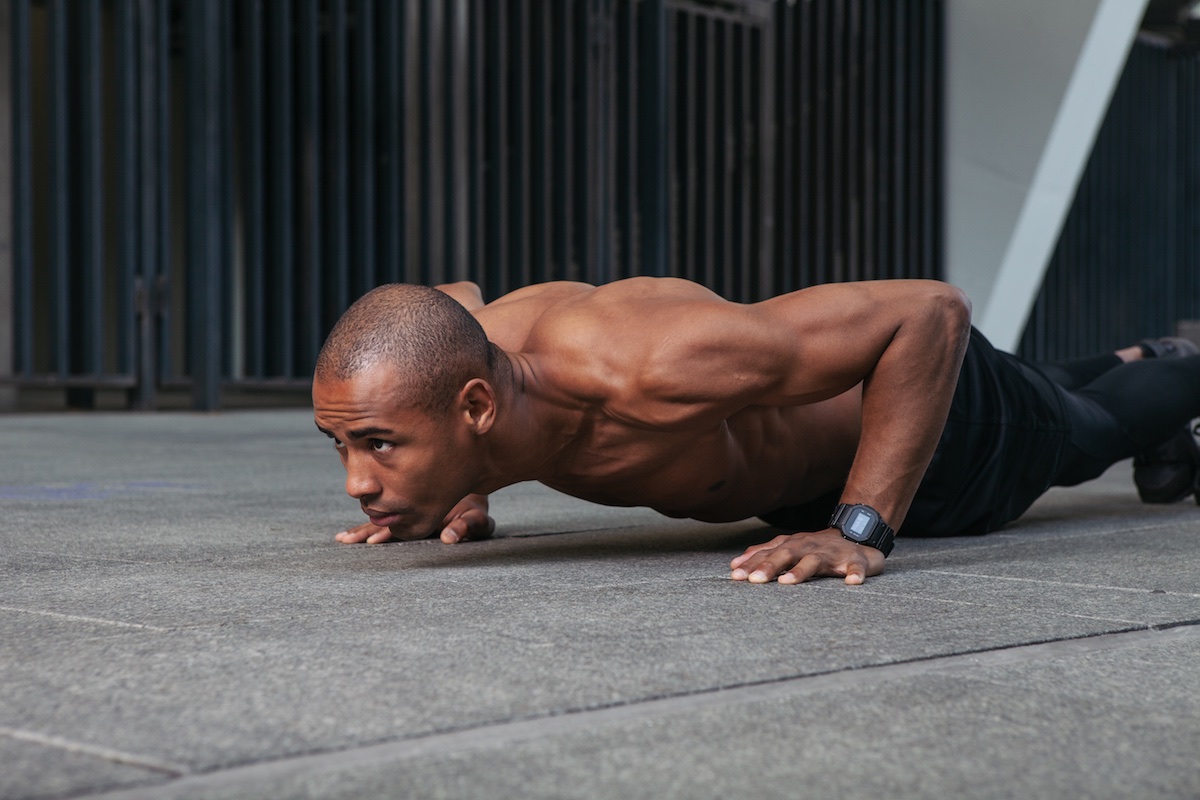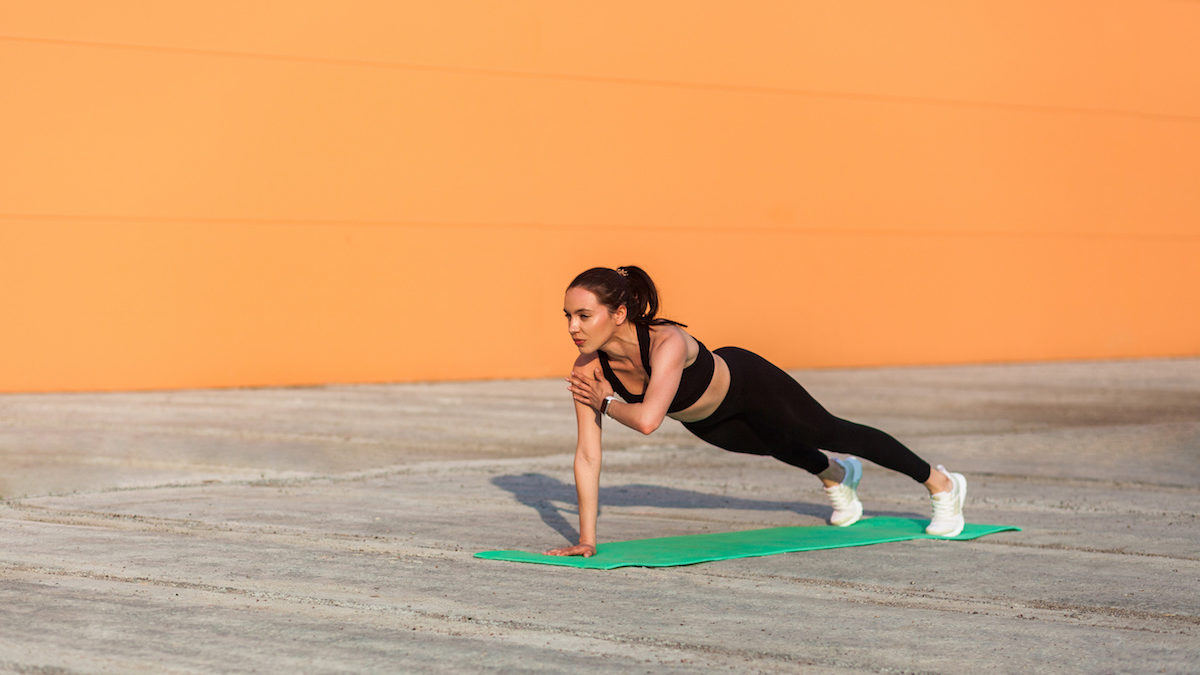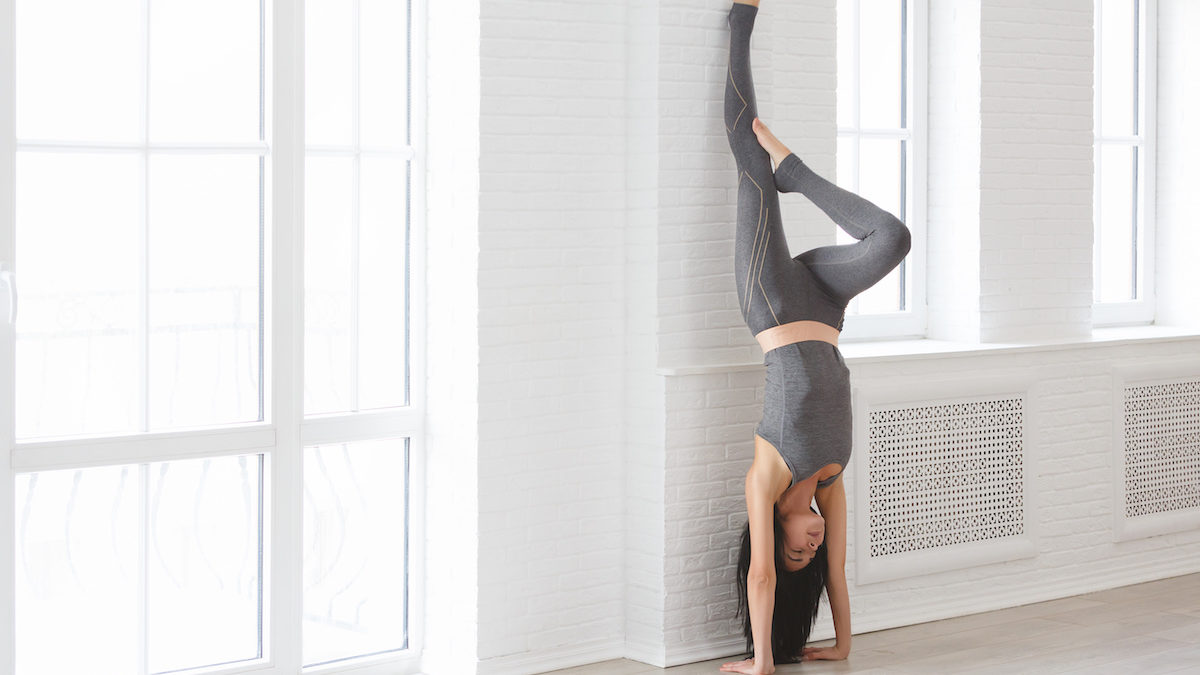8 PT-Approved Bodyweight Exercises We All Should Be Doing on the Regular

Don’t get us wrong, the gym is a sanctuary, an oasis, a paradise of iron and elliptical trainers. But if the lockdowns of the last year taught us anything it’s that an over-reliance on working out at your local gym can knock you sideways when access is taken away.
Variation is important then, and the ability to get your resistance training done with or without a never-ending weights rack. A range of bodyweight exercises in your workout toolkit is a must, providing an opportunity to sustain your gains, whether you’re backpacking around the world or having to isolate in your house for two weeks.
Here, personal trainer Shannon Gibbons lets us in on her top bodyweight exercises i.e. the ones every workout aficionado should know by heart.
Bodyweight Exercises Vs Weights Workout
“There are benefits to both bodyweight and strength training exercises,” explains Gibbons. “Weight training puts stress on your bones and connective tissue which in turn can help with preventing injury and overall health in the long run. With bodyweight exercises, you are using the weight of your body as resistance, which can be as challenging, just in a different way.”
Any form of bodyweight exercise is a completely natural thing to do, coming from a place that was likely used for survival. Our ancestors didn’t have squat racks let’s just put it that way. Bodyweight exercises are great at working out muscle groups you might usually ignore then. Maybe you’re a regular bench presser for example. Well, when you’re bench pressing your core is supported by the bench, and inactive as a result. But in a push-up, without an activated core you’re not going to be able to keep yourself up.
And so while you won’t put on a whole load of mass just using your bodyweight – you need heavy weights and low reps for that sort of build – you will massively impact your functional strength and improve your range of motion.

8 of The Best Bodyweight Exercises
“It is hard to pick the best bodyweight exercises because it can depend on what your goals are and what you are focusing on,” says Gibbons. “But movements that target the major muscle groups and different planes of motion are important. Whether that be more low impact, plyometric, or strength-focused there is a lot you can do with bodyweight exercises.”
For this magnificent seven, we’ve decided to go for exercises that require zero equipment. Pull-ups, we love you, but not everyone is going to have a bar with which to pull themselves up. You might need a wall though, more on that later.
Lunge
“Squats and Lunges are good for lower body strength, mobility, and core work,” says Gibbons. Both can of course be done with weights, but going without means you can focus on form. Just remember to up your rep count if you want to feel the burn.
Technique: Standing shoulder-width apart, step forward with one leg and slowly move your hips down until both knees are bent at a 90-degree angle. Keep the core engaged and don’t let your back knee touch the ground, before coming back up to a standing start and repeating on your other leg.
Top Tips: “It is important to remember to keep your chest up and core actively engaged,” says Gibbons, “with your weight evenly distributed in the feet. And don’t let your knees go too far over your toes.”
Classic Push-Up
“Pushups are great for building upper body strength and endurance without having weights on hand,” says Gibbons. In our no-equipment-necessary upper body workout guide, Men’s Health cover star Gilles Souteyrand recommends doing three push-up variations – the classic, a triceps push-up and a shoulder push-up – to work your whole upper body, with 20 crunches between each exercise.
Below we outline the classic, but in order to manoeuvre into other variations, all you need to do is adjust your hand and elbow positioning.
Technique: Start with your feet together and no more than 12 inches apart, your hands flat on the ground below your shoulders, and your arms straight. Breathe in as you bend your elbows while lowering your chest to slightly below the level of your bent elbow. Then breathe out as you push back up to the starting position for one rep.
Top Tips: “Make sure your body is in proper alignment, shoulders directly over the wrists and elbows at a 45-degree angle,” says Gibbons. “You want to do a full range of motion dropping all the way down and fully pushing up.”
Plank
“Planks are great for core strength,” says Gibbons. “Your arms and quads are at work as well. The basic plank can be the starting point for many other exercises so it is important to have this core move down to perform others properly.”
Technique: Get into a pushup position, ground your toes into the floor and squeeze those glutes to stabilize your body. Keep your neck and spine held as you look at a spot on the floor about a foot beyond your hands. Hold this position for the length of your rep.
Top Tips: “You want to make sure your shoulders are right over your wrists,” says Gibbons, “and your hips aren’t up in the air or sagging to the ground. You want a nice straight line parallel with the floor.”
Glute Bridges
“Glute Bridges are great for building your glutes muscles, the biggest muscle group in the body,” says Gibbons. “It’s very important to work these muscles as they are major stabilizers and affect mobility in the hips.” Starting with glute bridges will also help ease you into hip thrusts, scientifically the best exercise for building your glutes (you can find more great bodyweight exercises for working your glutes in our bum workout guide).
Technique: Lie with your back against the floor, knees bent, and feet flat on the ground. Keep your arms at your side with your palms down. Slowly lift your hips off the ground until your knees, hips, and shoulders form a straight line. Squeeze your bum hard and hold this bridge position before slowly coming back down.
Top Tips: “Remember to not over-extend and arch the back when lifting the hips,” says Gibbons. “Push your heels into the ground as you lift and tighten both your glutes and your core.”
Burpees
“Burpees are one of my favourite bodyweight exercises that involve the entire body and get the heart rate up,” says Gibbons. “There are modifications so you can perform a burpee at any level of fitness.”
Technique: A burpee is a tale of two halves; you have the pushup and then the jump. To kick things off, start in a squat position with your feet about shoulder-width apart. Put your hands to the floor in front of you so they’re just inside your feet. Kick your feet out and back so you’re in a pushup position.
With your body straight, do a pushup. Jumping your feet back to their starting position. Stand and reach your arms over your head. Jump quickly into the air, landing back where you started and ready to repeat.
Top Tips: The main thing to remember with a burpee is not to get sloppy in your plank to pushup and then when coming back up in a squat focusing on getting your feet fully planted on the ground and under your hips with your chest and core up and engaged.
Handstand Wall Walk
Being able to fling your feet up in the air and walk on your hands is an art not all of us are likely to master. If you’re on that journey then you may want to read our how to do a handstand guide, but until then there’s always the handstand wall walk, a cracking bodyweight exercise for both your upper body and your core.
Technique: Measure one leg’s distance away from the wall. Place your hands in this position, facing away from the wall. Walk one foot up to 90 degrees and push into the wall to lift your hips above your shoulders. Keep your hands directly under your shoulders so that your arms are vertical, pushing your weight into the floor to get a good grounding. Put the other foot on the wall keeping the whole body at a right angle.
Top Tips: As your strength and awareness increases, you will be able to put less pressure through your foot on the wall, and should be able to eventually find enough balance to complete a handstand sans wall.

Superman Hold
If it’s good enough for the man of steel, it’ll sure as anything work wonders for us mere mortals. While the Superman hold is one of the best bodyweight exercises for working most of the body, it’s especially potent on your lower back – perfect for those work-from-homers stuck beavering away at the dining table.
Technique: Grab a mat (you could use a rug too), and lie face down on it, with your legs straight and your arms stretched out in front of you. Raise both your arms and legs at the same time so that they are about five inches off the floor. Hold this position and then lower back to the starting position.
Top Tips: Make sure that your head and spine are in line with each other. If you’re feeling some strain on your neck halt the movement and see if you can get someone to check your form.
Bear Crawl
Get in touch with your animal side and build some real upper body bulk with the bear crawl. Simple but effective, it’ll also put strain on your core as you hold your body stable and keep your mind sharp as you get to grips with the coordination needed to crawl forward with your opposite leg.
Technique: Start on all fours and lift your knees so they are just hovering off the ground. Keep your back flat, your legs hip-width apart and your arms shoulder-width apart. Move one hand and the opposite foot forward an equal distance while staying low to the ground. Switch sides, moving the opposite hand and foot.
Top Tips: Once you’ve mastered the front bear crawl, see if you can manage crawling backwards. Space allowing, try and crawl 10 metres forward, then 10 back for the length of your rep.


















